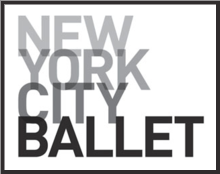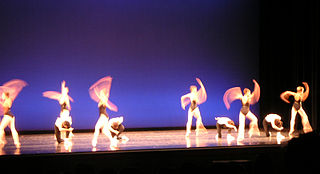
New York City Ballet (NYCB) is a ballet company founded in 1948 by choreographer George Balanchine and Lincoln Kirstein. Balanchine and Jerome Robbins are considered the founding choreographers of the company. Léon Barzin was the company's first music director. City Ballet grew out of earlier troupes: the Producing Company of the School of American Ballet, 1934; the American Ballet, 1935, and Ballet Caravan, 1936, which merged into American Ballet Caravan, 1941; and directly from the Ballet Society, 1946.
The American Ballet was the first professional ballet company George Balanchine created in the United States. The company was founded with the help of Lincoln Kirstein and Edward Warburg, managed by Alexander Merovitch and populated by students of Kirstein and Balanchine's School of American Ballet. Having failed to mount a tour, American Ballet began performing at the Old Met. After being allowed to stage only two dance performances in 1936 and an evening of dances choreographed to the music of Igor Stravinsky in 1937), Balanchine moved the company to Hollywood in 1938. The company was restarted as the American Ballet Caravan and toured North and South America, although it too folded after several years.
Le Baiser de la fée is a neoclassical ballet in one act and four scenes composed by Igor Stravinsky in 1928 and revised in 1950 for George Balanchine and the New York City Ballet. Based on Hans Christian Andersen's short story Isjomfruen, the work is an homage to Pyotr Ilyich Tchaikovsky, for the 35th anniversary of the composer's death. Stravinsky elaborated several melodies from early piano pieces and songs by Tchaikovsky in his score. A commission by Ida Rubinstein from 1927, the ballet was choreographed by Bronislava Nijinska and premiered in Paris on 27 November 1928.
Jewels is a three-act ballet created for the New York City Ballet by co-founder and founding choreographer George Balanchine. It premièred on Thursday, 13 April 1967 at the New York State Theater, with sets designed by Peter Harvey and lighting by Ronald Bates.

Apollo is a neoclassical ballet in two tableaux composed between 1927 and 1928 by Igor Stravinsky. It was choreographed in 1928 by twenty-four-year-old George Balanchine, with the composer contributing the libretto. The scenery and costumes were designed by André Bauchant, with new costumes by Coco Chanel in 1929. The scenery was executed by Alexander Shervashidze, with costumes under the direction of Mme. A. Youkine. The American patron of the arts Elizabeth Sprague Coolidge had commissioned the ballet in 1927 for a festival of contemporary music to be held the following year at the Library of Congress in Washington, D.C.
John Taras was an American ballet master, repetiteur, and choreographer.

Agon is a 22-minute ballet for twelve dancers with music by Igor Stravinsky. It was choreographed by George Balanchine. Stravinsky began composition in December 1953 but was interrupted the next year; he resumed work in 1956 and concluded on April 27, 1957. The music was premiered in Los Angeles at UCLA's Royce Hall on June 17, 1957, conducted by Robert Craft. Stravinsky himself conducted the sessions for the work's first recording the following day on June 18, 1957. Agon was first performed on stage by the New York City Ballet at the City Center of Music and Drama on December 1, 1957.
Tango is a ballet made by New York City Ballet balletmaster Peter Martins to Stravinsky's Tango (1940) arranged 1953 by the composer. The premiere took place September 14, 1983 at Tivoli Concert Hall, Copenhagen; the NYCB premiere was in February, 1984.
Piano–Rag–Music is a ballet made by Todd Bolender to Stravinsky's eponymous music from 1919. The premiere took place on June 23, 1972, as part of New York City Ballet's Stravinsky Festival at the New York State Theater, Lincoln Center.
Piano–Rag–Music is a ballet made by New York City Ballet balletmaster in chief Peter Martins to Stravinsky's eponymous music from 1919. The premiere took place on June 10, 1982, as part of City Ballets's Stravinsky Centennial Celebration at the New York State Theater, Lincoln Center.
Circus Polka: For a Young Elephant was written by Igor Stravinsky in 1942. He composed it for a ballet production that the choreographer George Balanchine did for Ringling Bros. and Barnum & Bailey Circus. The ballet was performed by fifty elephants and fifty ballerinas. In 1944, Stravinsky published an orchestration of the piece, which is now part of the repertoire of many orchestras.
Orpheus is a thirty-minute neoclassical ballet in three tableaux composed by Igor Stravinsky in collaboration with choreographer George Balanchine in Hollywood, California in 1947. The work was commissioned by the Ballet Society, which Balanchine founded together with Lincoln Kirstein and of which he was Artistic Director. Sets and costumes were created by Isamu Noguchi.
Elegy is a composition by Igor Stravinsky for solo viola composed in 1944. It was dedicated to the memory of Alphonse Onnou, the founder of the Pro Arte Quartet. The score bears no time signature, but the metronome marking sets the tempo at = 56. The opening section is in the style of a chant above a rippling accompaniment. The middle section contains elements of a fugue, though there are never more than two independent voices. After its climax, the Elegy closes with a recapitulation of its opening. The viola is directed to play with mute throughout.
Variations is a ballet made by New York City Ballet co-founder and founding choreographer George Balanchine to Stravinsky's Variations: Aldous Huxley in memoriam (1963–64). The premiere took place on Thursday, 31 March 1966 at the New York State Theater, Lincoln Center; Balanchine made a new version for City Ballet's 1982 Stravinsky Centennial Celebration.
Variations for Orchestra is the last ballet made by New York City Ballet co-founder and founding choreographer George Balanchine to Igor Stravinsky's Variations: Aldous Huxley in memoriam (1963–64). The premiere took place on Friday, 2 July 1982 at the New York State Theater, Lincoln Center.
Requiem Canticles is a ballet made for New York City Ballet's Stravinsky Festival by balletmaster Jerome Robbins to eponymous music from 1966 by Igor Stravinsky. The premiere took place June 25, 1972, at the New York State Theater, Lincoln Center.
Scherzo à la Russe is a ballet choreographed by George Balanchine to Stravinsky's music of the same name. The ballet was created for New York City Ballet's Stravinsky Festival, a tribute to the composer after his death, and premiered on June 21, 1972, at the New York State Theater, with the two lead roles originated by Karin von Aroldingen and Kay Mazzo.
Scènes de ballet is a suite of dance movements composed in 1944 by Igor Stravinsky. It was commissioned by Broadway producer Billy Rose for inclusion in the revue The Seven Lively Arts that opened at the Ziegfeld Theater on December 7, 1944.
Stravinsky Violin Concerto, originally titled Violin Concerto, is a neoclassical ballet choreographed by George Balanchine to Stravinsky's Violin Concerto. Balanchine had previously choreographed another ballet to the concerto in 1941 for the Original Ballet Russe, titled Balustrade, though it was not revived following a few performances. He then reused the concerto for New York City Ballet's Stravinsky Festival in 1972, a tribute to the composer following his death. The ballet premiered on June 18, 1972, at the New York State Theater.